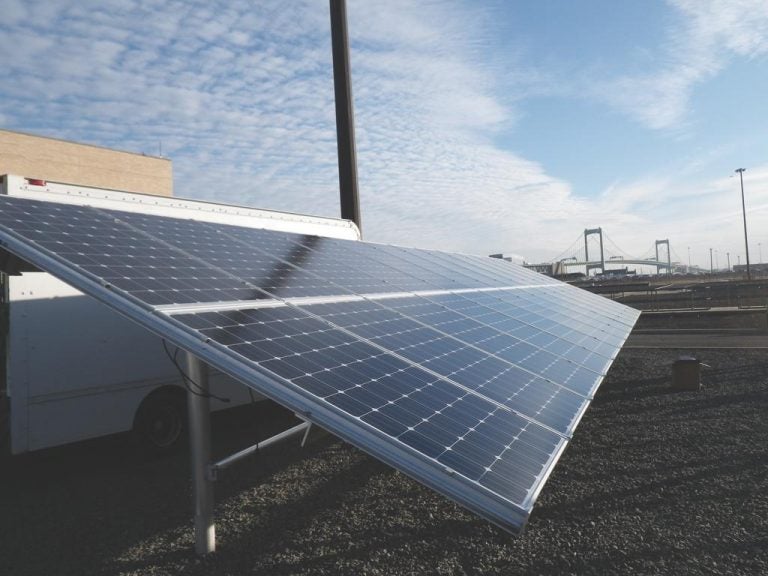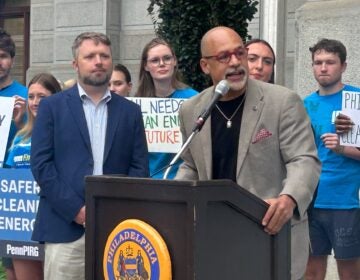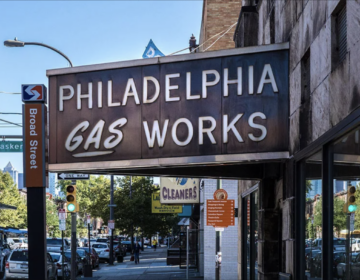Pa. grants $2M for solar tech at PGW’s liquefied natural gas plant
Philadelphia’s future LNG plant gets grant for solar panels. Environmentalists say that doesn’t make the fossil fuel project right.

A solar panel owned by the City of Philadelphia. (City of Philadelphia)
Philadelphia Gas Works’ planned liquefied natural gas plant got a $2 million state grant to install solar energy. The plant will be constructed at the utility’s Southwest Philadelphia site.
The $60 million Passyunk Energy Center is a partnership between the city-owned gas company and Liberty Energy Trust GP LLC, an energy company based in Conshohocken. The facility is expected to produce up to 120,000 gallons of LNG.
PGW’s Melanie McCottry said the grant gives the company an opportunity to upgrade the project without affecting ratepayers.
“The potential energy savings for installing solar at our location could reduce energy cost at our facility and it increases the overall return on investment of the sale of LNG from that site, increasing revenue, which then benefits our customers,” McCottry said.
The public-private entity had requested $8 million from the state’s Redevelopment Assistance Capital Program to install solar technology at the plant. The $8 million grant would have funded solar equipment able to generate 5.2 megawatts of power — enough electricity to support the energy needs of the LNG plant and other PGW operations at its Passyunk site. It would have become the largest solar installation in the city.
McCottry said it’s too early to say how the difference in grant funds allocated will change the proposed project. But she said the company will pursue whatever is possible with the money available, while continuing to look for funding for a bigger solar project without affecting its rates.
‘Any solar is better than no solar’
The LNG plant, approved by the City Council in June, is projected to bring in anywhere from $1.35 million to $4 million in revenue for PGW each year. But local environmental organizations have opposed the plan since its proposal, arguing that building a new fossil fuel plant is going backwards.
Matt Walker, the Clean Air Council’s advocacy director, said having solar panels on site doesn’t make the LNG project right.
“Any solar is better than no solar,” Walker said. “But it does goes against the city’s sustainability and climate goals to operate an LNG plant that locks us into 25 more years of natural gas at a time when scientists say we must rapidly transition off of fossil fuels to address the climate crisis.”
City officials argue the LNG facility won’t increase carbon emissions. A study by PGW has shown that while relying on fossil fuel, the plant will, in fact, reduce carbon emissions and could also reduce particulate matter, nitrogen oxides, and sulfur oxides.
City Councilman and Gas Commission chair Derek Green has called the project a bridge to a greener municipal energy portfolio and said that extra revenue will prevent the utility from having to raise customers’ rates.
If the project moves forward, it would become the second solar installation at the facility. Officials approved a 150-kilowatt solar array earlier this year as means to offset electricity being used at the existing plant.
LNG is produced by cooling methane gas to minus 260 degrees Fahrenheit, at which point it becomes a liquid, which is easier to store and transport.
PGW currently produces LNG at its Port Richmond plant and transports it to the Passyunk location for storage.
WHYY is your source for fact-based, in-depth journalism and information. As a nonprofit organization, we rely on financial support from readers like you. Please give today.







